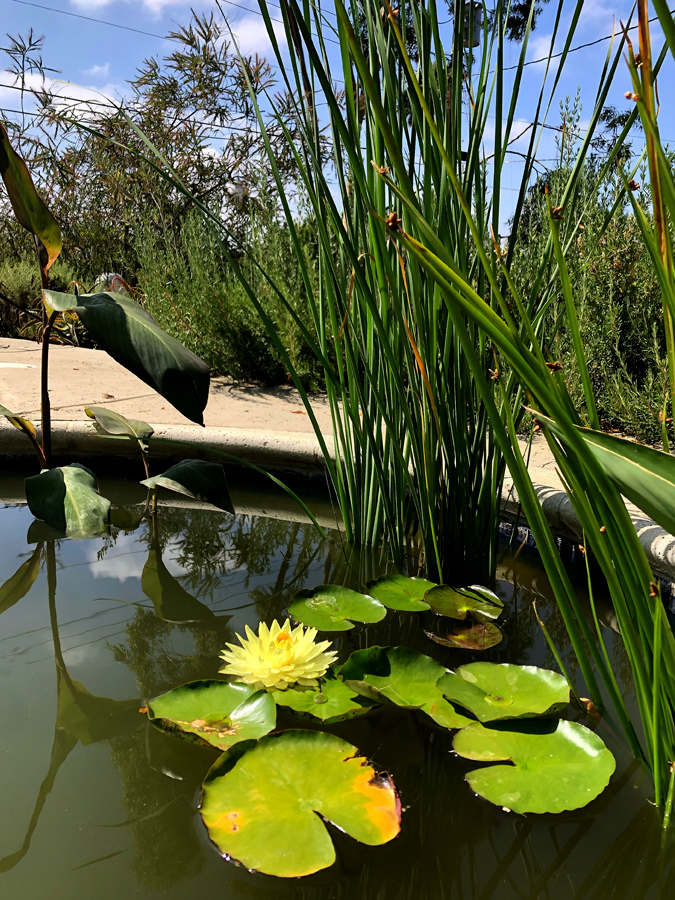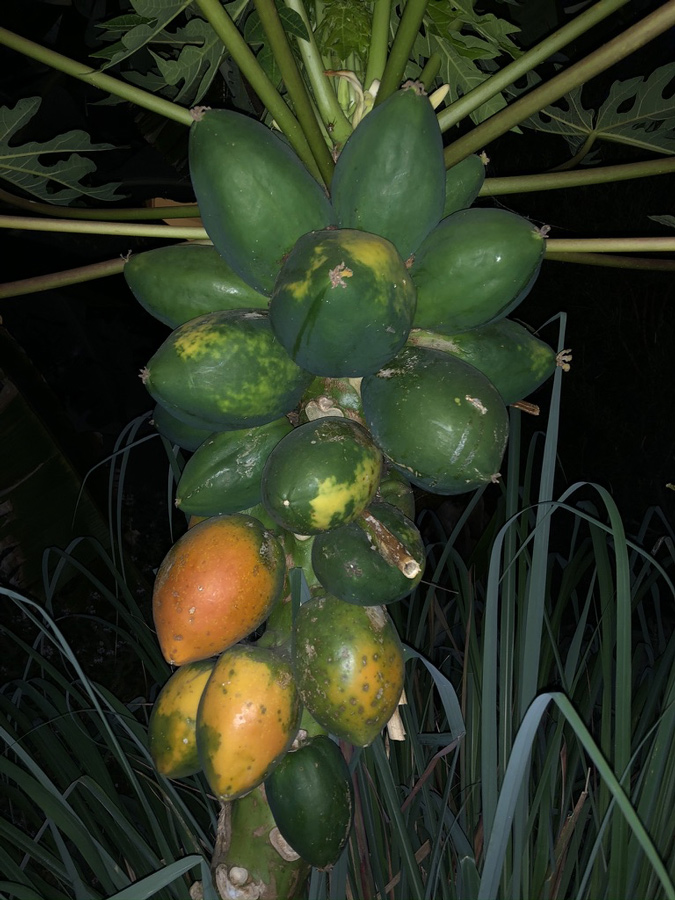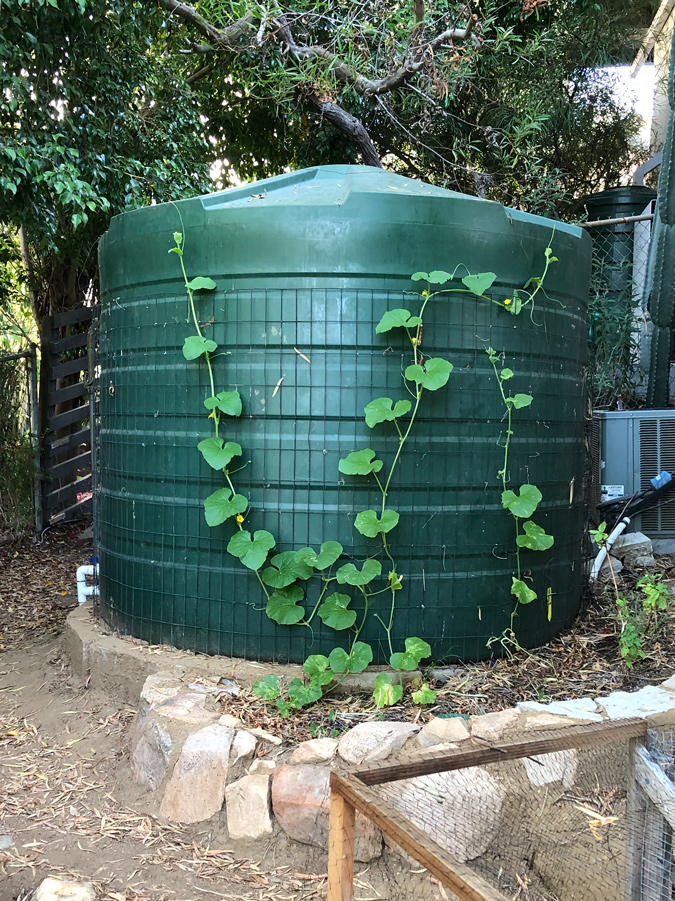Eagle Rock Food Forest is an experimental, developing permaculture site on a previously abandoned 1/4 acre residential property in the city of Los Angeles.
Eagle Rock Food Forest uses less water per capita than the city, state and national average, while growing more than 100 foods and maintaining a natural swimming pool, aquaponic fish farm, wildlife habitat, livestock, pets, vegetable gardens, hundreds of perennial trees and shrubs, 2 full-time residents and a guest unit.
-
 The swimming pool has been converted to a natural pond, filtered by native wetland plants. It is a habitat for beneficial insects and the birds that hunt them, and is safe and healthy for swimming by humans. It also provides ~12,000 gallons of water storage for irrigation and emergency drinking water.
The swimming pool has been converted to a natural pond, filtered by native wetland plants. It is a habitat for beneficial insects and the birds that hunt them, and is safe and healthy for swimming by humans. It also provides ~12,000 gallons of water storage for irrigation and emergency drinking water. -
Moringa, a nutrient-dense source of medicinal tea and food.
-
Fruit trees are irrigated with greywater and fertilized by chickens, who visit daily from their coops by tunnel. The chickens have regular access to Aprium, Apple, Mandarin Orange, Meyer Lemon, Peach, Pluerry and Plum trees.
-
Stairs and retaining walls are plastered with on-site clay-rich dirt, goat manure (from a neighbor in the desert), straw, and fermented prickly pear paddle juice (for binding, smoothing and water resistance).
-
 Papayas and lemongrass at night.
Papayas and lemongrass at night. -
Dried tobacco hanging from a Grevillea tree, which is being pruned over time to provide a living staircase for roof access.
-
 There is 16,000 gallons of rainwater storage capacity on site, with the largest tank connected to a high-pressure pump. Over all, 4,000 gallons are stored in tanks, with roughly 12,000 gallons stored in the natural pool. A network of pipes and valves allow many variations of circulation throughout the system between the tanks, pool, water features, and mulch basins. Nearly all municipal water is recycled. In the picture above, the overflow from the air conditioner condensor flows into a mulch basin and feeds the cucumber plants growing up the tank.
There is 16,000 gallons of rainwater storage capacity on site, with the largest tank connected to a high-pressure pump. Over all, 4,000 gallons are stored in tanks, with roughly 12,000 gallons stored in the natural pool. A network of pipes and valves allow many variations of circulation throughout the system between the tanks, pool, water features, and mulch basins. Nearly all municipal water is recycled. In the picture above, the overflow from the air conditioner condensor flows into a mulch basin and feeds the cucumber plants growing up the tank. -
Grapes grow from a chicken manure composting pen that's attached by tunnel to the coop. The vine grows up a trellis that shades a south-facing staircase, and is constructed from Bamboo poles collected from a neighbor's garden. At least 50 pounds of grapes per year grow on this vine with minimal irrigation and no commercial inputs.
-
Chickens for eggs, fertlizer, and many other functions.
-
 Four types of bananas are grown around a greywater-fed mulch basin. Banana plants are cut down and composted in the central pit after fruiting, increasing soil fertility, water-holding capacity, and biomass. The plants and large leaves create a cool shady environment, reduce air temperature and increase moisture in an otherwise hot and dry southwest-facing microcllimate. They also shade and help insulate the house interior while providing privacy and an immersive view from the bedroom.
Four types of bananas are grown around a greywater-fed mulch basin. Banana plants are cut down and composted in the central pit after fruiting, increasing soil fertility, water-holding capacity, and biomass. The plants and large leaves create a cool shady environment, reduce air temperature and increase moisture in an otherwise hot and dry southwest-facing microcllimate. They also shade and help insulate the house interior while providing privacy and an immersive view from the bedroom. -
Citrus trees are irrigated with greywater and fertilized by chickens. Varieties include Mandarin, Navel Orange, Eureka Lemon, Meyer Lemon, Key Lime, Tangelo, Makrut Lime, Loquat, and Oro Blanco.
-
Chickens have constant access by tunnel to a composting pen, where they deposit manure that is occasionally layered with wood chips and water. The composted manure is dug out as needed. Grape vines grow from the pen, feeding from the compost and producing 30-50 pounds of fruit per year. No cleaning or additional maintenance is needed.
-
Dragonflies breed in the natural pool and are an important part of the food chain.
-
Many useful and edible annual plants re-seed on their own every year.
-
Solar panels and battery storage provide electricity for the property and prevent outages. If necessary, the property can support all of its services off-grid indefinitely with monitoring.
-
Passionfruit vines grow up the side of the house onto a bamboo trellis that shades the southwest side of the deck and produces hundreds of fruits multiple times a year. The bamboo is harvested from the property and a neighbor's yard. The vines are irrigated with stored rainwater through a vermicomposting basin.